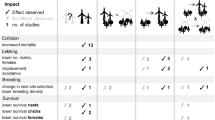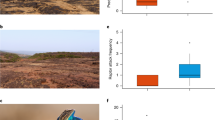Abstract
The undeniable environmental benefits of wind energy are undermined by the negative effects of wind farms on bird populations through mortality by collision with the energy-generating structures. Studies have documented morphological, ecological, and behavioral traits associated with vulnerability to wind turbines. However, practically all studies have concentrated on the effects on particular populations, and community-level analyses are lacking. Here we assess the susceptibility of species on the basis of their morphology, and examine the effect of selective mortality on the topology and dispersion of phylogenies, and on the structure and volume of the ecological morphospace of bird assemblages. Using an extensive database of bird occurrences and fatalities in a wind farm located in southern Mexico, and performing null models to establish statistical significance, we compared sets of affected and unaffected species in terms of their wing morphology and position in a phylogeny. We found that birds more likely to fly in the risk zone tend to be smaller, with longer wings, and with heavier wing loadings. Within this group, species more likely to collide with blades and die are smaller, with short wings, and supporting lighter wing loadings. These patterns determine that the set of species less affected distribute in morphospace leaving noticeable holes (morphologies not represented). Birds flying in the risk zone tend to be related to each other, but species that actually collide with turbines belong to several separate clades. These differential effects on morphology and phylogenetic diversity pose important and complex challenges to the conservation of birds in areas where wind farms are being established.




Similar content being viewed by others
References
Alif LA, Khan HA, Shobrak M, Williams J (2011) Cytochrome c oxidase subunit I barcoding of the green bee-eater (Merops orientalis). Genet Mol Res 10:3992–3998
Baerwald EF, Barclay RMR (2011) Patterns of activity and fatality of migratory bats at a wind energy facility in Alberta, Canada. J Wildl Manag 75:1103–1114
Baerwald EF, D′Amours GH, Klug BJ, Barclay RMR (2008) Barotrauma is a significant cause of bat fatalities at wind turbines. Curr Biol 18:R695–R696
Barrios L, Rodríguez A (2004) Behavioural and environmental correlates of soaring-bird mortality at on-shore wind turbines. J Appl Ecol 41:72–81
Bihn JH, Gebauer G, Brandl R (2010) Loss of functional diversity of ant assemblages in secondary tropical forests. Ecology 91:782–792
Binford LC (1989) A distributional survey of the birds of the Mexican state of Oaxaca. Ornithol Monogr 43:1–418
Blomberg SP, Garland T, Ives AR (2003) Testing for phylogenetic signal in comparative data: behavioral traits are more labile. Evolution 57:717–745
Brightsmith DJ (2005) Competition, predation, and nest niche shifts among tropical cavity nesters: phylogeny and natural history evolution of parrots (Psittaciformes) and trogons (Trogoniformes). J Avian Biol 36:64–73
Cadotte MW, Dinnage R, Tilman D (2012) Phylogenetic diversity promotes ecosystem stability. Ecology 98:S223–S233
Carrete M, Sánchez-Zapata J, Benítez JR, Lobón M, Montoya F, Donázar JA (2012) Mortality at wind-farms is positively related to large-scale distribution and aggregation in griffon vultures. Biol Conserv 145:102–108
de Lucas M, Janss GFE, Ferrer M (2004) The effect of a wind farm on birds in a migration point: the Strait of Gibraltar. Biodivers Conserv 13:395–407
de Lucas M, Janss GFE, Whitfield DP, Ferrer M (2008) Collision fatality of raptors in wind farms does not depend on raptor abundance. J Appl Ecol 45:1695–1703
Drewitt AL, Langston RHW (2006) Assessing the impacts of wind farms on birds. Ibis 148:29–42
Dussert C, Rasigni M, Palmari J, Rasigni G, Llebaria A, Marty F (1987) Minimal spanning tree analysis of biological structures. J Theor Biol 125:317–323
Evered DS (1990) Measures of wing area and wing span from wing formula data. Auk 107:784–787
Faith DP (1992) Conservation evaluation and phylogenetic diversity. Biol Conserv 61:1–10
Fargione J, Kiesecker J, Slaats MJ, Olimb S (2012) Wind and wildlife in the Northern Great Plains: identifying low-impact areas for wind development. PLoS One 7:e41468
Ferrer M, de Lucas M, Janss GFE, Casado E, Muñoz AR, Bechard MJ, Calabuig CP (2012) Weak relationship between risk assessment studies and recorded mortality in wind farms. J Appl Ecol 49:38–46
Fonseca CR, Ganade G (2001) Species functional redundancy, random extinctions and the stability of ecosystems. J Ecol 89:118–125
García-Romero A, Oropeza-Orozco O, Galicia-Sarmiento L (2005) Land-use systems and resilience of tropical rain forests in the Tehuantepec Isthmus, México. Environ Manag 34:768–785
Gerhold P, Pärtel M, Tackenberg O, Hennekens SM, Bartish I, Schaminée JHJ, Fergus AJF, Ozinaga WA, Prinzing A (2011) Phylogenetically poor plant communities receive more alien species, which more easily coexist with natives. Am Nat 177:668–680
Gotelli NJ, Graves GR (1996) Null models in ecology. Smithsonian Institution Press, Washington
Gotelli NJ, Ulrich W (2012) Statistical challenges in null model analysis. Oikos 121:171–180
Griffiths CS, Barrowclough GF, Groth JG, Mertz L (2004) Phylogeny of the Falconidae (Aves): a comparison of the efficacy of morphological, mitochondrial, and nuclear data. Mol Phylogenet Evol 32:101–109
Gross R, Leach M, Bauen A (2003) Progress in renewable energy. Environ Int 29:105–122
Guindon S, Gascuel O (2003) A simple, fast and accurate algorithm to estimate large phylogenies by maximum likelihood. Syst Biol 52:696–704
Hartmann K, André J (2013) Should evolutionary history guide conservation? Biodivers Conserv 22:449–458
Hebert PDN, Ratnasingham S, de Waard JR (2003) Barcoding animal life: cytochrome c oxidase subunit 1 divergences among closely related species. Proc R Soc Lond B 270:S96–S99
Heemsbergen DA, Berg MP, Loreau M, van Hal JR, Faber JH, Verhoef HA (2004) Processes explained by interspecific functional dissimilarity. Science 306:1019–1020
Holbrook KM, Loiselle BA (2009) Dispersal in a Neotropical tree, Virola flexuosa (Myristicaceae): does hunting of large vertebrates limit seed removal? Ecology 90:1449–1455
Horn JW, Arnett EB, Kunz TH (2008) Behavioral responses of bats to operating wind turbines. J Wildl Manag 72:123–132
Howell SNG, Webb S (1995) A guide to the birds of Mexico and northern Central America. Oxford University Press, New York
Huidobro L, Morrone JJ, Villalobos JL, Álvarez F (2006) Distributional patterns of freshwater taxa (fishes, crustaceans and plants) from the Mexican Transition Zone. J Biogeogr 33:731–741
Hüppop O, Dierschke J, Exo KM, Fredrich E, Hill R (2006) Bird migration studies and potential collision risk with offshore wind turbines. Ibis 148:90–109
Janss GFE (2000) Avian mortality from power lines: a morphologic approach of a species-specific mortality. Biol Conserv 95:353–359
Kembel SW, Cowan PD, Helmus MR, Cornwell WK, Morlon H, Ackerly DD, Blomberg SP, Webb CO (2010) Picante: R tools for integrating phylogenies and ecology. Bioinformatics 26:1463–1464
Kuvlesky WP Jr, Brennan LA, Morrison ML, Boydston K, Ballard BM, Bryant FC (2007) Wind energy development and wildlife conservation: challenges and opportunities. J Wildl Manag 71:2487–2498
Martin GR (2011) Understanding bird collisions with man-made objects: a sensory ecology approach. Ibis 153:239–254
Martínez-Abraín A, Crespo J, Berdugo M, Gutiérrez L, Lafuente A, Mañas A, de Miguel JM (2012) Causes of human impact to protected vertebrate wildlife parallel long-term socio-economical changes in Spain. Anim Conserv. doi:10.1111/j.1469-1795.2012.00599.x
Minderman J, Pendlebury CJ, Pearce-Higgins JW, Park KJ (2012) Experimental evidence for the effect of small wind turbine proximity and operation on bird and bat activity. PLoS One 7:e41177
Morgado E, Günther B, Gonzalez U (1987) On the allometry of wings. Rev Chil Hist Nat 60:71–79
Mouquet N, Devictor V, Meynard CN, Munoz F, Bersier LF, Chave J, Couteron P, Dalecky A, Fontaine C, Gravel D, Hardy OJ, Jabot F, Lavergne S, Leibold M, Mouillot D, Münkemüller T, Pavoine S, Prinzing A, Rodrigues AS, Rohr RP, Thébault E, Thuiller W (2012) Ecophylogenetics: advances and perspectives. Bio Rev Camb Philos Soc. doi:10.1111/j.1469-185X.2012.00224.x
Mwangi PN, Schmitz M, Scherber C, Roscher C, Schumacher J, Scherer-Lorenzen M, Weisser WW, Schmid B (2007) J Ecol 95:65–78
Norberg U (1994) Wing design, flight performance, and habitat use in bats. In: Wainwright PC, Reilly SM (eds) Ecological morphology. University of Chicago Press, Chicago, pp 205–239
Oksanen J, Blanchet FG, Kindt R, Legendre P, O′Hara RB, Simpson GL, Solymos P, Stevens MHH, Wagner H (2011) Vegan: community ecology package. R package version 1.17-8. http://CRAN.R-project.org/package=vegan. Accessed Nov 2011
Pace ML, Cole JJ, Carpenter SR, Kitchell JF (1999) Trophic cascades revealed in diverse ecosystems. Trends Ecol Evol 14:483–488
Peres CA (2000) Effects of subsistence hunting on vertebrate community structure in Amazonian forests. Conserv Biol 14:240–253
Proches S, Wilson JRU, Richardson DM, Rejmánek M (2008) Searching for phylogenetic pattern in biological invasions. Glob Ecol Biogeogr 15:5–10
Ricklefs RE (2012) Species richness and morphological diversity of passerine birds. Proc Natl Acad Sci USA 109:14482–14486
Ricklefs RE, Miles DB (1994) Ecological an evolutionary inferences from morphology: an ecological perspective. In: Wainwright PC, Reilly SM (eds) Ecological morphology. University of Chicago Press, Chicago, pp 13–41
Ricklefs RE, Travis J (1980) A morphological approach to the study of avian community organization. Auk 97:321–338
Santos BA, Arroyo-Rodríguez V, Moreno CE, Tabarelli M (2010) Edge-related loss of tree phylogenetic diversity in the severely fragmented Brazilian Atlantic forest. PLoS One 5:e12625
Santos H, Rodrigues L, Jones G, Rebelo H (2013) Using species distribution modelling to predict bat fatality risk at wind farms. Biol Conserv 157:178–186
Sibley DA (2000) National Audubon Society the Sibley guide to birds. Alfred A Knopf, New York
R Development Core Team (2010) R: a language and environment for statistical computing. R Foundation for Statistical Computing, Vienna, Austria. ISBN 3-900051-07-0. http://www.R-project.org/. Accessed Nov 2011
Tennekes H (1996) The simple science of flight: from insects to jumbo jets. MIT Press, Cambridge
Villegas-Patraca R, Macias-Sanchez S, MacGregor-Fors I, Munoz-Robles C (2012) Scavenger removal: bird and bat carcass persistence in a tropical wind farm. Acta Oecol 43:121–125
Walker B, Kinzig A, Langridge J (1999) Plant attribute diversity, resilience, and ecosystem function: the nature and significance of dominant and minor species. Ecosystems 2:95–113
Webb CO, Ackerly DD, McPeek MA, Donoghue MJ (2002) Phylogenies and community ecology. Annu Rev Ecol Syst 33:475–505
Weiser MD, Kaspari M (2006) Ecological morphospace of New World ants. Ecol Entomol 31:131–142
Wiens JJ, Ackerly DD, Allen AP, Anacker BL, Buckley LB, Cornell HV, Damschen EI, Davies TJ, Grytnes JA, Harrison SP, Hawkins BA, Holt RD, McCain CM, Stephens PR (2010) Niche conservatism as an emerging principle in ecology and conservation biology. Ecol Lett 13:1310–1324
Willis CG, Ruhfel B, Primack RB, Miller-Rushing AJ, Davis CC (2008) Phylogenetic patterns of species loss in Thoreau′s woods are driven by climate change. Proc Natl Acad Sci USA 105:17029–17033
Acknowledgments
We would like to thank to Jaime Gasca, Jorge Schondube, and Fabricio Villalobos for providing useful comments throughout the entire research, and the INECOL staff which helped with field work. Adolfo Navarro and Patricia Escalante allowed the access to bird collections. L. H.-A. was supported by Consejo Nacional de Ciencia y Tecnología Grant for master studies.
Author information
Authors and Affiliations
Corresponding author
Appendix
Appendix
See Table 3.
Rights and permissions
About this article
Cite this article
Herrera-Alsina, L., Villegas-Patraca, R., Eguiarte, L.E. et al. Bird communities and wind farms: a phylogenetic and morphological approach. Biodivers Conserv 22, 2821–2836 (2013). https://doi.org/10.1007/s10531-013-0557-6
Received:
Accepted:
Published:
Issue Date:
DOI: https://doi.org/10.1007/s10531-013-0557-6




